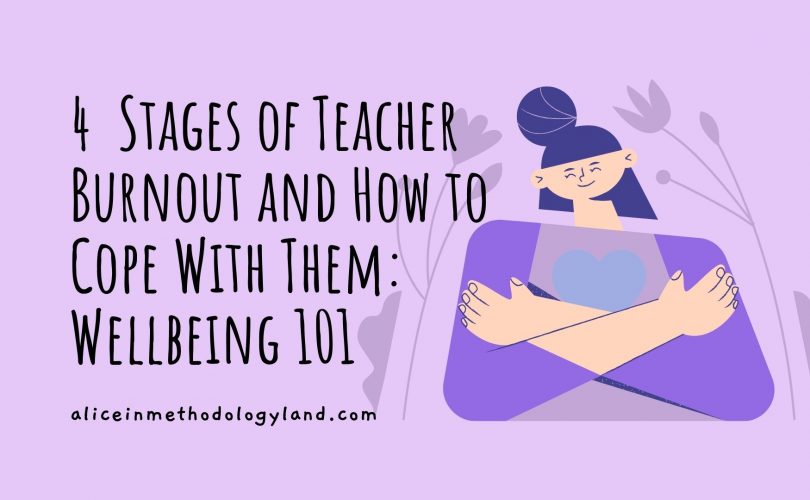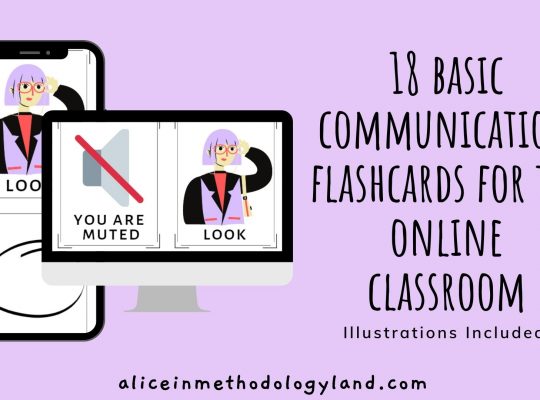The years 2020 and 2021 have been years of great development in teaching, and also years where so many teachers cracked under the pressure of online teaching. Teacher burnout hit all of us hard.
To start this article, I have to share a disclaimer:
I usually write more academic articles, and I focus on methodology and giving practical examples, but this article will include different content because I know many people can relate.
I have been teaching online for 6 years now, and I feel very equipped to teach online. There were a lot of teacher trainings I conducted and I saw so many teachers drowning in tasks, methodology, tools, and last but not least, drowning in fear. This is the best phrase I can coin to describe what 2020 meant for so many educators.
As someone with experience, it was terribly hard, almost excruciating to watch fellow educators getting lost in all of the information, panicking, and just not succeeding in distance learning. Just standing there as an outsider, trying to help, but ultimately being completely unable to change anything. It takes so much time to learn to use different apps and the concepts of distance learning. It can take years, and no one was given enough time or support to learn and practice.
The main idea every educator needs to understand and repeat like a mantra every single day is:
Emergency remote teaching is not the same as distance learning.
Emergency remote teaching is not the same as distance learning.
EMERGENCY REMOTE TEACHING IS NOT THE SAME AS DISTANCE LEARNING.
Nobody should be expected to completely transform their teaching methods overnight.
The 4 stages of burnout
Now, let’s talk about wellbeing, and the main reason for not feeling well – burnout.
There are some signs of extreme burnout and some things you can try to do to at least minimize the effect of burnout because at this point, burnout is here and it’s not going away anytime soon.
According to Veninga and Spradley’s (1981) (this article uses an adapted version with 4 stages), there are 5 stages of burnout.
The most important part of our wellbeing is realizing at which stage of burnout we are before it is too late. We usually notice it when we reach rock bottom, and it’s much harder to go back to our normal selves from this stage.
Stage 1 & signs
Honeymoon phase – In this stage, we are enthusiastic about the tasks ahead of us, we are very eager to prove ourselves, we are committed, productive, and satisfied. We are also optimistic and we accept responsibility readily. You probably think now: This is not burnout! This is the first step to burnout because this is where the pressure of all responsibilities you took on starts to crumble on you. If you develop coping mechanisms and start prioritizing your own mental health, you may forever stay in this phase. Not a lot of people do, which brings us to stage 2.
Stage 1 remedies: yes, this phase of teacher burnout also requires preventing
- Learn to say no to your supervisor. Explain that you already have too many tasks politely by repeating all of them or show some product of your work (materials, lesson plans, and anything extra you had to create or do that day or week). When you are an overachiever, people presume they can just pile up more work on you.
- Learn to say no to parents of your students. If parents contact you out of your available time, do not answer. Repeat this response to their messages until they start respecting your boundaries and until they remember that you have a family as well.
- LEARN TO SAY NO TO YOURSELF. This is the hardest thing anyone can achieve but it is possible. Make yourself draw the line where your duty stops. Every teacher loves their students but there is so much we can do. Don’t try to be a hero at the expense of your own health.
Stage 2 & signs
In stage two we usually start to realize that some days are harder than others. We start celebrating the end of the day like it’s a holiday, and not just time to stop working. Common symptoms include anxiety, neglect of oneself, irritability, difficulty focusing, lower productivity, forgetfulness, and avoiding making a decision on something.
At this stage, some medical symptoms that affect your body start to appear and they include fatigue, headaches, heart palpitations, high blood pressure, reduced sleep quality, no appetite, or excessive appetite.
Stage 2 remedies: preventing teacher burnout while there’s still time
- Make the decision the same day, do not go to bed thinking about it. If you keep procrastinating and not making a decision, it will linger in your mind as you try to fall asleep and it results in sleepless nights.
- Give yourself time to relax by doing what you like. Yes, you are entitled to relaxation even in the midst of chaos. By relaxing and doing your favorite activity you become refreshed and more motivated to continue working.
- Divide your work with family members, colleagues, or friends. For example, grading a standardized test, or cutting out flashcards. Those things can be done by anyone while you relax.
- Remove yourself from a stressful situation if you feel that stress is affecting your body. If something is too much at the moment, apologize, say that you do not feel well, and ask to continue this some other time when the other person also calms down. This includes parents, colleagues, and your supervisors.
Stage 3 & signs
In stage 3 the symptoms from stage two start to intensify and they last longer. New symptoms include anger and aggressive behavior, cynism, denial of problems at work or at home, feeling threatened, panicked, pressured, or out of control. Other signs include missed work deadlines and/or targets, constant tiredness in the mornings, physical illness, procrastination, resentfulness, social withdrawal from friends and/or family.
Stage 3 remedies: some more ideas for preventing teacher burnout
- Start a stress journal – It is pretty self-explanatory why journals can be soothing. I am more of a scrapbook person, so I used to make scrapbooks when I was younger.
- Take a nap – YES, NAPPING HELPS EVERY TIME! JUST NAP, TRUST ME!
- If you are feeling attacked, talk about it with a friend/colleague/family member.
- Make a drastic change – from dying your hair to trying some food you never tasted before. Anything that can lead to some positive emotion will help.
- Spend some time in nature or at least outdoor if you do not have any natural environment around you.
Stage 4 & signs
In stage four of burnout, symptoms become critical. When we mention burnout, we usually think about this phase. In this phase, we may experience behavioral changes, chronic headaches, stomach or bowel problems, neglect of personal needs, continuation or increase in escapist activities, desire to “drop out” of society, the need to move away from work or friends/family, feeling empty inside, obsession over problems at work or in life, a pessimistic outlook on work and life and self-doubt.
Stage 4 remedies: final tips for preventing teacher burnout
- Fully unplug – turn off all electronic devices and stop answering emails and messages.
- Recognize your breaking point and try not to get to it again – analyze your own situation, discuss it with someone, and pinpoint the moment everything fell apart.
- Schedule free time in your calendar – close your weekend completely. Do not get close to a computer! Use the computer only if you don’t use it at work and if you want to play video games or do something relaxing.
- Find time for hobbies – however small they may be, something that makes you feel whole is worth spending time on.
- Try meditating – this one does not work for me, but many people benefit from it, and you can find so many free guides and apps nowadays to guide you.
- Seek professional help if you are experiencing insomnia or problems with your eating habits.
TO CONCLUDE: the ”three R” approach to recovery
Recovering from burnout is a long process, but we can simplify it with the ”three R” approach.
- Recognize – be aware of the warning signs of burnout.
- Reverse – work on minimizing the damage by reaching out for support and finding ways to manage stress.
- Resilience – build up your resilience by investing in yourself emotionally and mentally, because in the end, YOU MATTER THE MOST.
You might have many or just a few symptoms, but please never ignore them. Don’t be afraid to talk about your feelings with someone, but at the same time, don’t expect a magic wand to solve this problem because ultimately, the only person that can help you is you. It may seem impossible sometimes, but you are in control of your life, so don’t let any school, parent, admin, or any kind of teaching position make you feel miserable – it’s just not worth it. There are so many things that can be done, and always focus on preventing teacher burnout, not fixing the concequences.
Reference:
Veninga, R., & Spradley, J. (1981). The work-stress connection. Boston: Little Brown.
Have you ever been in a similar situation? Is there any way to avoid burnout in the time we live in, as educators? Feel free to share your experience with teacher burnout or opinions in the comments, or via the contact page!

Click here to explore my store where 100% of materials are forever free!
All the materials except lesson plans and 30+ page interactive activity books will be free FOREVER! Why? Because sharing is caring, and 2020 hasn’t been kind to all of us.
Don’t forget to leave a review when you download materials! It’s just a minute of your time, and it means a lot to me.
P.S. The store and the freebie library are not the same thing – the freebie library has some extra materials like conference presentations and webinar recordings which are not available in the store
The subscription link for the store is below my bio in every post.






